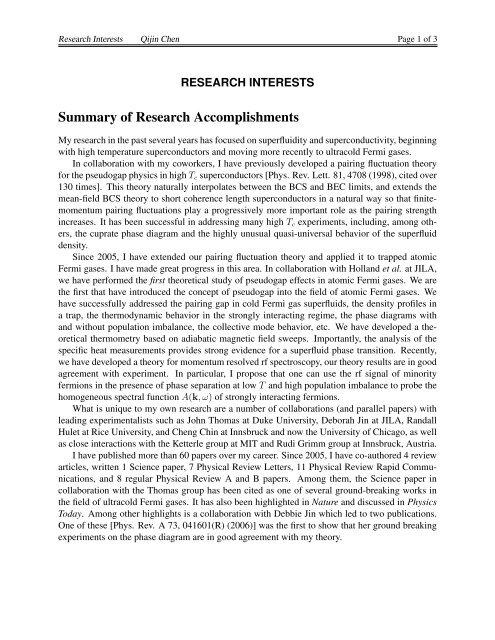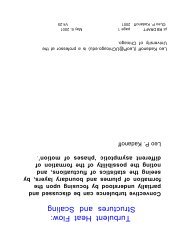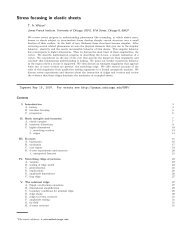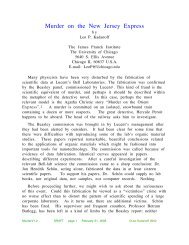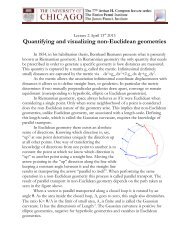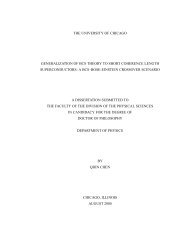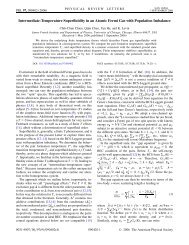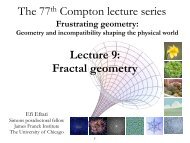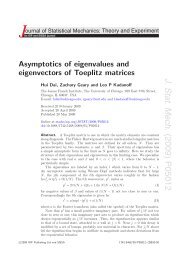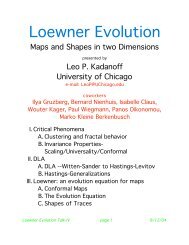Summary of Research Accomplishments
Summary of Research Accomplishments
Summary of Research Accomplishments
You also want an ePaper? Increase the reach of your titles
YUMPU automatically turns print PDFs into web optimized ePapers that Google loves.
<strong>Research</strong> Interests Qijin Chen Page 1 <strong>of</strong> 3<br />
RESEARCH INTERESTS<br />
<strong>Summary</strong> <strong>of</strong> <strong>Research</strong> <strong>Accomplishments</strong><br />
My research in the past several years has focused on superfluidity and superconductivity, beginning<br />
with high temperature superconductors and moving more recently to ultracold Fermi gases.<br />
In collaboration with my coworkers, I have previously developed a pairing fluctuation theory<br />
for the pseudogap physics in high Tc superconductors [Phys. Rev. Lett. 81, 4708 (1998), cited over<br />
130 times]. This theory naturally interpolates between the BCS and BEC limits, and extends the<br />
mean-field BCS theory to short coherence length superconductors in a natural way so that finitemomentum<br />
pairing fluctuations play a progressively more important role as the pairing strength<br />
increases. It has been successful in addressing many high Tc experiments, including, among others,<br />
the cuprate phase diagram and the highly unusual quasi-universal behavior <strong>of</strong> the superfluid<br />
density.<br />
Since 2005, I have extended our pairing fluctuation theory and applied it to trapped atomic<br />
Fermi gases. I have made great progress in this area. In collaboration with Holland et al. at JILA,<br />
we have performed the first theoretical study <strong>of</strong> pseudogap effects in atomic Fermi gases. We are<br />
the first that have introduced the concept <strong>of</strong> pseudogap into the field <strong>of</strong> atomic Fermi gases. We<br />
have successfully addressed the pairing gap in cold Fermi gas superfluids, the density pr<strong>of</strong>iles in<br />
a trap, the thermodynamic behavior in the strongly interacting regime, the phase diagrams with<br />
and without population imbalance, the collective mode behavior, etc. We have developed a theoretical<br />
thermometry based on adiabatic magnetic field sweeps. Importantly, the analysis <strong>of</strong> the<br />
specific heat measurements provides strong evidence for a superfluid phase transition. Recently,<br />
we have developed a theory for momentum resolved rf spectroscopy, our theory results are in good<br />
agreement with experiment. In particular, I propose that one can use the rf signal <strong>of</strong> minority<br />
fermions in the presence <strong>of</strong> phase separation at low T and high population imbalance to probe the<br />
homogeneous spectral function A(k, ω) <strong>of</strong> strongly interacting fermions.<br />
What is unique to my own research are a number <strong>of</strong> collaborations (and parallel papers) with<br />
leading experimentalists such as John Thomas at Duke University, Deborah Jin at JILA, Randall<br />
Hulet at Rice University, and Cheng Chin at Innsbruck and now the University <strong>of</strong> Chicago, as well<br />
as close interactions with the Ketterle group at MIT and Rudi Grimm group at Innsbruck, Austria.<br />
I have published more than 60 papers over my career. Since 2005, I have co-authored 4 review<br />
articles, written 1 Science paper, 7 Physical Review Letters, 11 Physical Review Rapid Communications,<br />
and 8 regular Physical Review A and B papers. Among them, the Science paper in<br />
collaboration with the Thomas group has been cited as one <strong>of</strong> several ground-breaking works in<br />
the field <strong>of</strong> ultracold Fermi gases. It has also been highlighted in Nature and discussed in Physics<br />
Today. Among other highlights is a collaboration with Debbie Jin which led to two publications.<br />
One <strong>of</strong> these [Phys. Rev. A 73, 041601(R) (2006)] was the first to show that her ground breaking<br />
experiments on the phase diagram are in good agreement with my theory.
<strong>Research</strong> Interests Qijin Chen Page 2 <strong>of</strong> 3<br />
Current <strong>Research</strong> Interests<br />
I have very broad research interests. For example, I have made significant scientific contributions<br />
in experimental condensed matter physics, and also had one year’s training in superstring theory.<br />
My primary focus is on the physics <strong>of</strong> superfluidity and related phenomena in ultracold atomic<br />
Fermi gases, while I am also interested in other areas outlined below.<br />
1. Ultracold atomic Fermi gases, optical lattices and quantum simulation<br />
Superfluidity in ultracold atomic Fermi gases is one <strong>of</strong> the most exciting research areas in condensed<br />
matter and atomic physics in recent years. Via Feshbach resonances, one can tune the<br />
attractive interaction between fermionic atoms from very weak to very strong. This makes it possible<br />
to observe Bose-Einstein condensation (BEC) in quantum degenerate Fermi gases directly<br />
over the entire range <strong>of</strong> the BCS-BEC crossover. Furthermore, this has created a strong hope that<br />
study <strong>of</strong> these systems may help us understand high Tc superconductivity. Another exciting tunable<br />
parameter in atomic Fermi gases is the population imbalance between the two spin species. The<br />
associated physics has turned out to be very rich. Added recently to this richness is the tunable<br />
mass ratio between the pairing atoms. Finally, optical lattices <strong>of</strong> atomic traps may be used to simulate<br />
typical as well as exotic condensed matter systems, e.g., the Hubbard model, so that study <strong>of</strong><br />
such simulated systems may provide a solution to unsolved problems in condensed matter physics.<br />
Even further, one can engineer many new systems to study exotic quantum phenomena.<br />
Over the past a few years, this field has seen very rapid progress. In 2003, the Jin group<br />
at JILA and the Grimm group at Universität Innsbruck, Austria made a big breakthrough and<br />
achieved molecular condensation in trapped atomic Fermi gases <strong>of</strong> 40 K and 6 Li, respectively. In<br />
2004, condensation <strong>of</strong> Cooper pairs was observed in 40 K by the Jin group and in 6 Li by the Grimm<br />
group and the Ketterle group at MIT. Evidence <strong>of</strong> superfluid phase transition were observed in<br />
thermodynamic behavior <strong>of</strong> 6 Li by the Thomas group at Duke and the Levin group in Chicago. In<br />
2005, the Ketterle group observed vortex lattices in 6 Li, which is the most definitive signature <strong>of</strong><br />
superfluidity. Population imbalance effects have become one <strong>of</strong> the hottest subjects since 2006, led<br />
by the MIT group and the Hulet group at Rice University. Since then, there has been a bloom in<br />
the study <strong>of</strong> optical lattices. Recently, synthetic gauge field and orbital effects in cold atoms have<br />
become new hot topics.<br />
A number <strong>of</strong> theorists have been working in the area <strong>of</strong> Fermi gases. However, their work has<br />
mostly been based on either the mean-field BCS-Leggett theory at zero temperature or the finite<br />
temperature Noziéres–Schmitt-Rink approach at Tc. The latter lacks self-consistency and cannot<br />
possibly predict a pseudogap. Other theoretical work has been based on the Bose liquid theory,<br />
and lacks proper treatment <strong>of</strong> the important fermionic pairing interaction.<br />
Our pairing fluctuation theory, originally developed for the pseudogap physics in high Tc superconductivity,<br />
has turned out very successful when applied to ultracold atomic Fermi gases. My<br />
current research includes fixing a couple <strong>of</strong> minor defects <strong>of</strong> this theory and apply it to more experiments<br />
or make more predictions. Of course, my research does not necessarily have to do with<br />
this theory. For example, one may proceed with completely different theories with optical lattices,<br />
synthetic gauge fields, etc.
<strong>Research</strong> Interests Qijin Chen Page 3 <strong>of</strong> 3<br />
2. Strongly correlated electrons<br />
I am interested in strongly correlated electron systems in general. The cuprates, organic, and<br />
heavy fermion (super)conductors are good examples <strong>of</strong> such systems. The new classes <strong>of</strong> Febased<br />
pnictide superconductors are believed to be strongly correlated as well. These systems call<br />
for new theories beyond the Landau Fermi liquid picture, which has been a foundation for modern<br />
solid state physics.<br />
High Tc, organic, heavy fermion and Fe-based pnictide superconductors<br />
High Tc superconductivity is arguably the greatest challenge in condensed matter physics. There<br />
has recently been a growing body <strong>of</strong> evidence which supports the relevance <strong>of</strong> precursor superconductivity,<br />
either through pairing fluctuations or vortex fluctuations, in the underdoped (pseudogapped)<br />
cuprates. Alternatively, new phases (e.g., antiferromagnet, insulating state) and quantum<br />
critical physics may come into play. There are more questions than answers. I am interested in<br />
any outstanding issues, such as the evolution <strong>of</strong> superfluid density with hole doping, transport<br />
properties, the superconductor-insulator transition at the lower critical doping, vortices and Nernst<br />
effects, Andreev reflection in the pseudogap regime, the one gap vs two gaps debate, etc.<br />
The phase diagrams <strong>of</strong> organic superconductors are very similar to those <strong>of</strong> the cuprates. There<br />
has been preliminary evidence for the existence <strong>of</strong> the pseudogap in these materials. The symmetry<br />
<strong>of</strong> the order parameter is still far from clear. Our theoretical explanation for the highly unusual T 3/2<br />
power law observed in the low T penetration depth measurements in the BEDT family has been an<br />
significant step toward understanding the symmetry and possible pseudogap phenomena in these<br />
superconductors. Heavy fermion superconductors also have similar phase diagrams, and some<br />
may exhibit quantum critical behavior. Interestingly, the discovery <strong>of</strong> Fe-based superconductors<br />
has invalidated the general belief that copper is the key to high Tc superconductivity whereas iron is<br />
<strong>of</strong>ten thought to be detrimental to superconductivity. It has now seemed to be a consensus that the<br />
order parameter <strong>of</strong> most Fe-based superconductors has an s± symmetry. Nevertheless, evidence<br />
for other symmetries to exist are also found in some materials. There are still many important<br />
questions to answer, including the most important pairing mechanism.<br />
3. Topological insulators, nanoscience, spintronics, and quantum computing<br />
Topological insulators have become a very hot field over the past couple <strong>of</strong> years. One important<br />
question is to find interesting physics beyond the single particle picture and find potential<br />
applications. Nanoscale physics, spintronics and quantum computing have great potentials for industrial<br />
applications. They are <strong>of</strong>ten interrelated. I have always been interested in these exciting<br />
areas. Optical lattices are also interrelated with nanoscale physics, quantum information science<br />
and quantum computing. One may use optical lattices to study topological insulators. In particular,<br />
the p + ip superfluid may be a topological superfluid, which can be used to study Majorana<br />
fermions. These Majorana fermions are believed to be able to be used for topological quantum<br />
computing.


